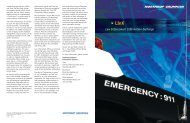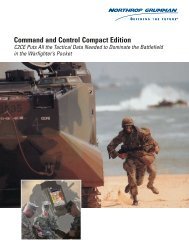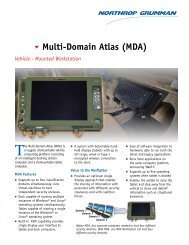Pythagoras: A New Agent-based Simulation System - Northrop ...
Pythagoras: A New Agent-based Simulation System - Northrop ...
Pythagoras: A New Agent-based Simulation System - Northrop ...
Create successful ePaper yourself
Turn your PDF publications into a flip-book with our unique Google optimized e-Paper software.
<strong>Pythagoras</strong>: A <strong>New</strong> <strong>Agent</strong>-<strong>based</strong> <strong>Simulation</strong> <strong>System</strong><br />
thermal image of a camouflaged person standing in the foliage. Such foliage could be<br />
modeled in <strong>Pythagoras</strong> as having a concealment value of 100% in band A and 0% in<br />
band B.<br />
Sensors also have a field of view and, for modeling humans, a probability that the agent<br />
is looking forward (i.e., in the direction of travel), to the side, or to the rear. Terrain<br />
features reduce the probability of line of detection differently in each band.<br />
Representation of Terrain<br />
All agents exist in a user-defined playbox of up to 1000 × 1000 pixels. On the playbox,<br />
a user can create terrain features—polygons that have a floor, a ceiling, and factors for<br />
mobility; concealment in each of the three signature bands; and protection that reduces<br />
the weapon’s effectiveness. Currently, a pixel can be associated with at most one terrain<br />
feature. <strong>Agent</strong>s can either move on the terrain or floor or operate at an altitude.<br />
Sample Scenarios<br />
<strong>Pythagoras</strong> has two major advantages:<br />
• It can be used quickly to assess various sample scenarios.<br />
• It can be combined with more complex and detailed models to provide insights into<br />
situations that may not be possible with other simulations.<br />
Rapid prototyping of scenarios, weapons, sensors, behavior patterns, etc., allows users<br />
to undertake complex problems in new ways without the burden of months of software<br />
development. Several sample scenarios are discussed below.<br />
Village Patrol. We have used <strong>Pythagoras</strong> to study crowd behavior in an antiterrorist/<br />
force protection scenario, represented as a village patrol, developed for the Marine<br />
Corps to evaluate various night-vision devices in peacekeeping operations. Figure 4<br />
shows a screen shot of the “play forward” capability of the <strong>Pythagoras</strong> GUI for that<br />
scenario. The scene is a village with buildings, parks, and streets, represented in Figure 4<br />
as large areas of color—e.g., the geometric shapes such as rectangles and trapezoids<br />
denote buildings. The blue dots represent Marines, the red dots are peaceful villagers,<br />
and the orange dots are hostile villagers. The hostiles include a terrorist leader, located<br />
in a religious structure, who can communicate with the hostiles, warning them of the<br />
presence of the Marines.<br />
Marine agents patrol the village at night, inspecting the villagers and looking for<br />
terrorists. The Marines are directed in part by a scout/sniper team that is strategically<br />
placed to help spot villagers. The villagers and terrorists alike move toward the food<br />
distribution point at the harbor at the top of the screen. Peaceful villagers, once<br />
approached by Marines and found to have proper identification and no weapons, are<br />
directed to the food distribution point. Hostile villagers attempt to avoid the Marines<br />
and are shackled in place after the Marines find and inspect them. Measures of effectiveness<br />
(MOEs) include the number of villagers detected and fed, the number of<br />
hostiles shackled, and the number of hostiles reaching the food distribution point, a<br />
potentially disastrous event.<br />
We first used this scenario to establish a night-vision-capability base case by modeling<br />
the probability of detection for the <strong>Pythagoras</strong> sensors, applying the results of physics-<br />
Technology Review Journal • Spring/Summer 2003 53






